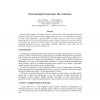12 search results - page 1 / 3 » Detecting Digital Tampering by Blur Estimation |
SADFE
2005
IEEE
13 years 10 months ago
2005
IEEE
With powerful computer and mighty software, seasoned users could turn digital media into what they want. The detection of digital tampering has become a crucial problem. In most o...
ICPR
2006
IEEE
13 years 10 months ago
2006
IEEE
Region duplication forgery, in which a part of a digital image is copied and then pasted to another portion of the same image in order to conceal an important object in the scene,...
IWDW
2007
Springer
13 years 11 months ago
2007
Springer
The compositing of two or more people into a single image is a common form of manipulation. We describe how such composites can be detected by estimating a camera’s intrinsic par...
MMSEC
2005
ACM
13 years 10 months ago
2005
ACM
When creating a digital composite of, for example, two people standing side-by-side, it is often difficult to match the lighting conditions from the individual photographs. Lighti...
ICASSP
2010
IEEE
13 years 5 months ago
2010
IEEE
In many application scenarios digital images play a basic role and often it is important to assess if their content is realistic or has been manipulated to mislead watcher’s opi...

